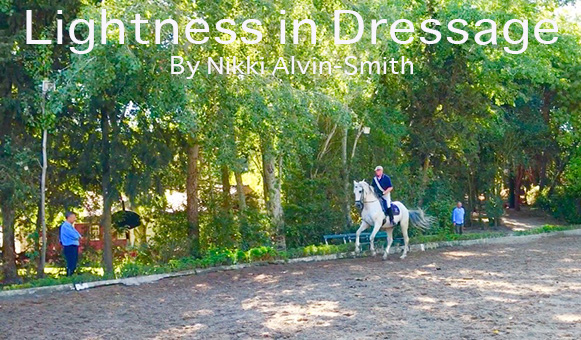Lightness in Dressage
By Nikki Alvin-Smith
I heard that the French School is dead? That the German training methods have by now so dominated dressage training in the modern day that the French School is no longer detectable? Is it true? And what is the difference between them? Do you know?
As an experienced dressage trainer/clinician/coach/competitor I would have to concur that there is little evidence in the top echelons of dressage sport to showcase much in the way of ‘descents de main’ and ‘rassembler’ in the Big Tour arena. It is not just a comparison between German and French Schools of dressage training, for the development of dressage training encompasses many countries, from the British Duke of Newcastle, to the Spanish and Portuguese masters and many more. The training systems all melt into one large dressage pot.
Perhaps the famous écuyer Francois  L’Hotte would be turning in his grave at the prominence of Rollkür, in this author’s opinion is an abusive method of training. According to the photos posted online, Rollkür is apparently even utilized as a training method by the renowned Spanish Riding School of Vienna (not in Spain at all). A sad state of affairs indeed and which I dearly hope will be corrected in the future. This abhorrent method of riding the horse with his head deep down on his chest by means of forceful rein manipulation is not to be mistaken for the suppling exercises of the bascule of the horse for brief periods to stretch the neck, which is entirely useful and kind to the horse.
L’Hotte would be turning in his grave at the prominence of Rollkür, in this author’s opinion is an abusive method of training. According to the photos posted online, Rollkür is apparently even utilized as a training method by the renowned Spanish Riding School of Vienna (not in Spain at all). A sad state of affairs indeed and which I dearly hope will be corrected in the future. This abhorrent method of riding the horse with his head deep down on his chest by means of forceful rein manipulation is not to be mistaken for the suppling exercises of the bascule of the horse for brief periods to stretch the neck, which is entirely useful and kind to the horse.
Alois Podhasky, past Director of the Spanish Riding School, who was the mentor to my husband Paul’s trainer, James Belman in Dulwich, London, would also be turning in his grave.
Paul and I both began our dressage training following Alois Podhasky as a result of the early influence of James Belman. British international Grand Prix rider Dane Rawlins is another prodigy of Belman, and it is interesting to see how experiences with various trainers and clinicians have influenced our training. Paul and I have been fortunate to work with French, Portuguese, Spanish and German masters. In the latter category, the legendary Herbert Rehbein was a significant influence on us both. It is not about your nationality, it is about your knowledge about lightness in dressage and true self-carriage of the horse.
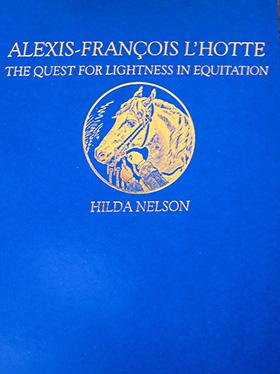 The history of the French School is well defined by Alexis-Francois L'Hotte in his book Quest for Lightness and he offers a good starting point for our discussion. L’Hotte was a General in the French Cavalry. Other names in the French School such as Baucher, D'Abzac and de Carpentry may also be known to many for their constant quest for perfection and lightness and the search for the true art of dressage.
The history of the French School is well defined by Alexis-Francois L'Hotte in his book Quest for Lightness and he offers a good starting point for our discussion. L’Hotte was a General in the French Cavalry. Other names in the French School such as Baucher, D'Abzac and de Carpentry may also be known to many for their constant quest for perfection and lightness and the search for the true art of dressage.
As an accomplished écuyer himself, L'Hotte was praised in his day as the most learned and most complete écuyer. He lived an austere life and was a model cavalryman, and throughout his career he was also known for his silence or limited words when teaching. I don't know about you - but I've had my share of those trainers too. Not always the most helpful. But despite his sometimes almost mute behavior, L'Hotte exhibited excellent knowledge of the training of dressage and brought much wit to the riding hall.
As many trainers do, L’Hotte experimented with different styles and methods of training including those that had been laid down by those trainers that came before him.
If we play with the application of the Baucher method and his work with the methods of Comte d'Aure, and his spiritual teacher Rousselet, we may find ourselves in disagreement with some of the methods, given the training advice and knowledge that has come later. That is not to say that there is not value in some of the training methods suggested, but rather we must use our common sense as trainers of the horse to divine which methods are not just successful in the road to haute ecole success, but methods which are fair to the welfare of the horse.
Dressage is in a constant state of flux, and as students of its art we must be vocal in our opinions particularly if we see activity that involves any abuse of the horse.
As a dressage aficionado it is important to trot the world and understand the different cultural methods of training from both traditional and modern day perspectives. It is also imperative when training to understand the requirements in training for breeds of horses from different regions, in order to gain insight into which methods you employ on particular breeds. For example, while the Andalusian horse seems to have magically gained in size to match the desire for bigger competition horses and the sales numbers of the Warmboods for competition,(much to the chagrin of the dedicated ANCCE breeder I might add), their demonstrated talent and ability to collect easily for the piaffe and passage are still very much apparent. However, so is the challenge for floating extended gaits that are magnified in the Warmblood pedigree. As the Andalusian works with a different conformation and a tighter back, it may require a more ‘French’ approach to the early work. What do I mean by this?
When you begin training a talented big-moving Warmblood, you should ride him very much forward. You will not run him off his hooves or out of rhythm or onto his forehand, but you will want to keep his large mass moving decidedly forward and straight. He will find this easy to do. On the other hand, if you do the same with an Iberian horse you may find yourself in trouble with a dreaded break at the 3rd vertebrae. A topic I write about fixing extensively in my blog Dressage Art in Motion. This is because the topline of the Iberian horse is significantly different. The hindquarters are often higher than the withers, the back may be shorter than average and the crest of the neck thicker with less ‘play’ in the neck/head or gullet connection. A Baroque horse then will necessarily require much more training from the seat earlier in his career than a Warmblood as you must also ride the horse forward and straight, but you must also offer a very light bit contact to ensure that the horse moves to the bit but does not come behind the vertical. How do you keep the Baroque horse true in the bridle? By using less hand.
It is also true that at the beginning of dressage training the progress of the Iberian horse may be slower than that of the Warmblood. If you have been bullied as a trainer by owners wanting quick results of moving a horse up the levels, but know that the Iberian bred horse is still ‘holding’ in his back and needs more time to move correctly to the bridle, then my advice is to stay your ground. If the foundation laid is not true, then it will be apparent later in soundness issues in the hocks and back, and incorrect acceptance of the rein throughout the horse’s career (rein lame).
L'Hotte talks of The School of Hannover (in a very interesting and humorous way I might add). He was not impressed with their Haute Ecole although impressed by their riding 'exterior' and hunt. He also visited the Royal Trakehner stables, and Austria and described the horses he found there as 'cafe au lait', something we might now refer to as ‘vanilla’. As in Germany, he found not one single stallion amongst them in Austria as they not allowed to be bred outside of Hannover by order of the King of Hannover. What he did find present in Austria however, five Andalusian breeds from Lippiza.
I have no bias here for I bred, imported, trained and competed Hanoverian, Oldenburg and Dutch horses for twenty plus years before adding Andalusian and Lusitano breeding in the late 1980’s and in Europe have competed the Iberian horse with great fondness with help from my present day Swiss coach Greta Kemmer.
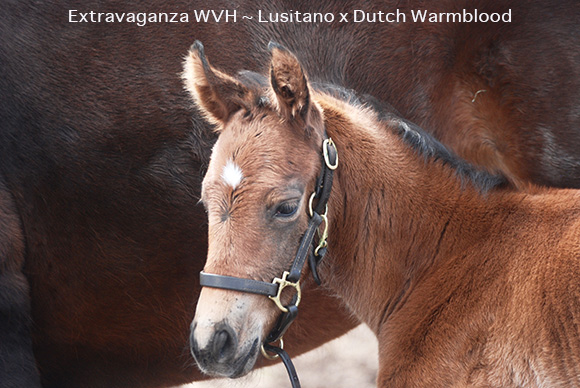
L’Hotte suggested these horses were, “the perfect round horse closer to the ground and fit for the manege riding which is beautifully orchestrated under gas lights.”
I've been fortunate to have similarly visited these places in my lifetime and to enjoy the horsemanship and some training at these locations. There is a stunning similarity to what he experienced and what we experienced and L'Hotte's writing makes you wish you had seen it all back then.
Reading the details on the applications of the aids and the training of the dressage mount also echoes the kindness in teachings of the more modern day masters such as the late Dr. Klimke and the less modern day masters Alois Podhajsky, Brenderup and Oliveira, the influences that you will see in all the dressage work taught and exhibited to-day are clearly evident.
Perhaps there is a blend today of 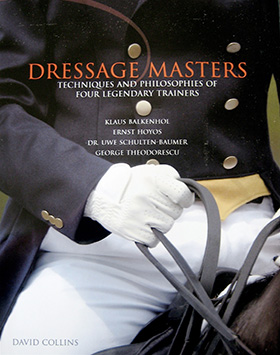 Steinbrecht and Baucher and all that has come before and surely we have evolved to take the best of both worlds? Perhaps it was not the German training and methods that made horses move on automatic pilot as L'Hotte suggests, but perhaps those that are trained by purists in Haute Ecole and also Circus Haute Ecole is what begs the difference. Does it matter on which side of The Danube the training is completed? In fact if you look today many of our own riders and trainers, Heather Bender and Tina Konyot for example, were trained in 'trick riding' before coming to dressage. Both these riders have beautiful position and use of seat in the saddle.
Steinbrecht and Baucher and all that has come before and surely we have evolved to take the best of both worlds? Perhaps it was not the German training and methods that made horses move on automatic pilot as L'Hotte suggests, but perhaps those that are trained by purists in Haute Ecole and also Circus Haute Ecole is what begs the difference. Does it matter on which side of The Danube the training is completed? In fact if you look today many of our own riders and trainers, Heather Bender and Tina Konyot for example, were trained in 'trick riding' before coming to dressage. Both these riders have beautiful position and use of seat in the saddle.
“When does the horse do the work of his on volition.” L'Hotte asks? This is still a very valid point for the cornerstone of good riding today. As trainers we must do our due diligence and understand the consequences of what and how we teach the horse.
It is also interesting to see that even in days of yore there was an appreciation of the lady rider in the art of dressage. Of course, as royalty were the sponsors for many trainers it is not a big surprise to see color plates of Marie-Antionette astride her fiery black horse, information on how an 'amazone' should dismount, complete with photo (and yes, actually a Jack Russell in the picture too, the breed was a pre-requisite for any dressage yard back then eh?), in the writings of L’Hotte. Also included in his works are photos of Francois Baucher favorite pupil Pauline Cuzent. Anna Fillis (yes, James Fillis's daughter) who grew up in Haute Ecole in France is another lady écuyer covered. It's great to see some credit given in L’Hotte’s works, not just to the great male riders of the day, but also the women. Some riding and jumping with no bridles - how's that for trick riding for the ladies!
So the message on lightness in dressage from my perspective is that yes, lightness is of paramount importance. As a trainer I keep the faith and am constant in my admonition of any excess use of the rein, particularly the inside rein during training. As long as the horse accepts the rein through his body equally on both sides of his body, then the inside rein should be used as lightly as possible. Having said that I am not all about constant pushing of the horse onto the outside rein. Everything has a time and a place for its use.
Education in the theory of dressage, its application and its development through the ages is an important part of training the horse. Only through understanding the biomechanical actions of the horse and with a clear eye to the individual horse’s conformation and temperament, can we provide a clear route that will facilitate every horse reaching his potential in the art of dressage. And yes, one lifetime is not enough to learn all there is to know and there is something to learn from everyone.
Almost 20 years ago Paul and I extended our horse breeding program from warmbloods, primarily Hanoverian and Dutch, to include Andalusian and Lusitano lines. Our trips to Spain and Portugal were filled with the search for the perfect stallions but also increasingly included visits to most of the notable horse barns in Spain and Portugal.
Most recently we found ourselves horse shopping at Antonio Monteiro Borba’s farm in Lisbon, (famed home of Nuno Oliveria, who was started as an apprentice by Antonio Borba’s grandfather), where Paul rode young dressage prospects in front of Mr. Borba’s watchful eye.
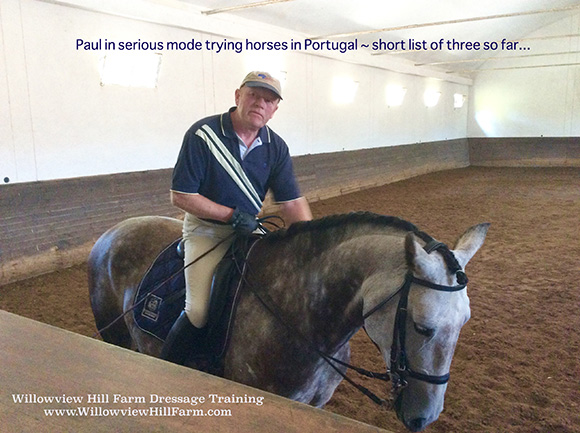
Once the tryouts were completed, Mr. Borba kindly invited Paul to ride his most prized horse, the famous Rico. Although Rico showed some signs of age and was technically in retirement, he gave everything a gallant try. It was fun for Paul to ride such a notable 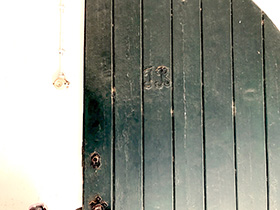 horse and put him through his Grand Prix paces. Rico has influenced the Lusitano breed tremendously. Originally trained by Mr. Borba, Rico was then trained by Kyra Kyrklund who had good success including at Hartpury, UK shows, even beating out Carl Hester and Utopia at PSG. Later Anky von Grunsven would showcase the horse at the Lusitano festival, and Borba told us that she rode the horse very briefly before the event, then hopped on to demonstrate the horse impeccably to the audience at the festival. This showcased the art of good training. Rico went on to the yard of Duarte, before coming home for retirement.
horse and put him through his Grand Prix paces. Rico has influenced the Lusitano breed tremendously. Originally trained by Mr. Borba, Rico was then trained by Kyra Kyrklund who had good success including at Hartpury, UK shows, even beating out Carl Hester and Utopia at PSG. Later Anky von Grunsven would showcase the horse at the Lusitano festival, and Borba told us that she rode the horse very briefly before the event, then hopped on to demonstrate the horse impeccably to the audience at the festival. This showcased the art of good training. Rico went on to the yard of Duarte, before coming home for retirement. 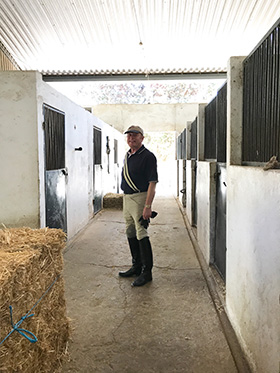
Mr. Borba gave Paul and impromtu lesson, which was very kind as this master of dressage was walking with a stick and clearly recovering from a medical issue. What a treat. The most wonderful compliment Paul received was when Borba told him, “ You ride as we do. That is what I saw and why I invited you to ride my horse.” So all those years of training that Paul received, in particular those early foundation years following classical dressage and Alois Podhasky under Belman’s stewardship were acknowledged.
It is very important as a trainer to constantly be improving your knowledge, and to resource truly educated minds to help you develop your own skill set.
While my days in the European competition ring are for the most part in the rear view mirror, I do not forget the constant strive for the perfect score and major focus that Grand Prix competition requires. Neither do I forget the horses and trainers that helped teach me and continue to help me, along the way. Every horse of every breed has much to offer in the dressage arena, as does every rider of any ability. Come share the passion!
About the author: Nikki Alvin-Smith is a professional freelance writer and content creator, who works with a variety of publications and manufacturers worldwide. She is an international Grand Prix dressage trainer/clinician who has competed in Europe at the Grand Prix level earning scores of over 72%. Together with her husband Paul, who is also a Grand Prix rider, they operate Willowview Hill Farm, a private horse breeding/training farm in Stamford, NY. Please visit her website at https://www.nikkialvinsmithstudio.com to learn more.



